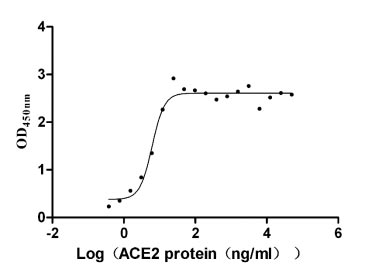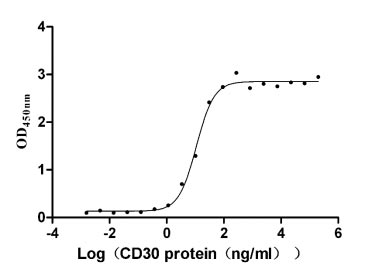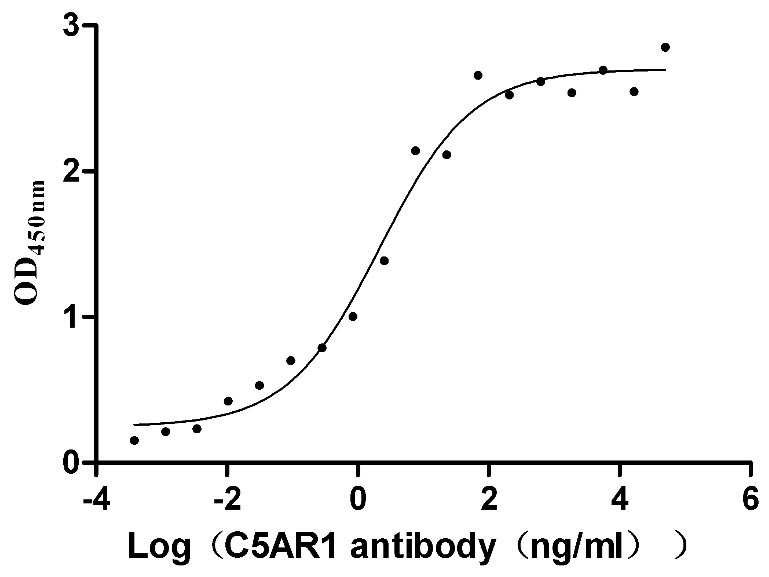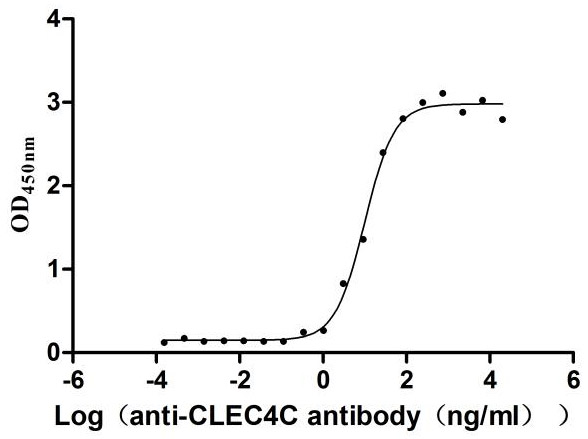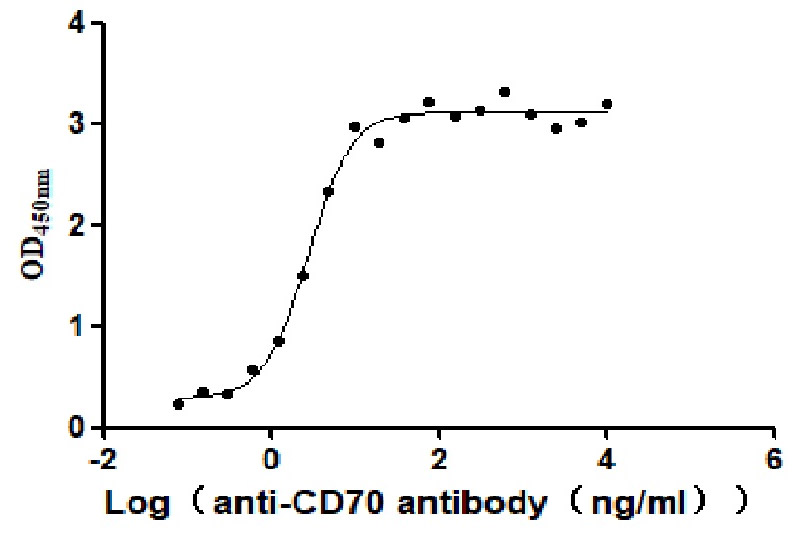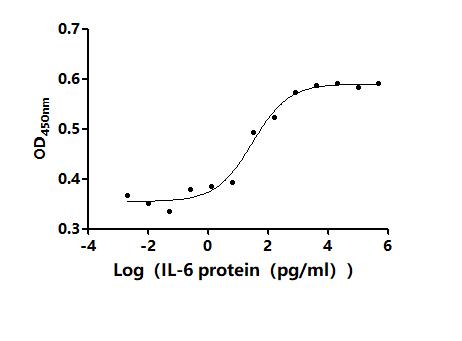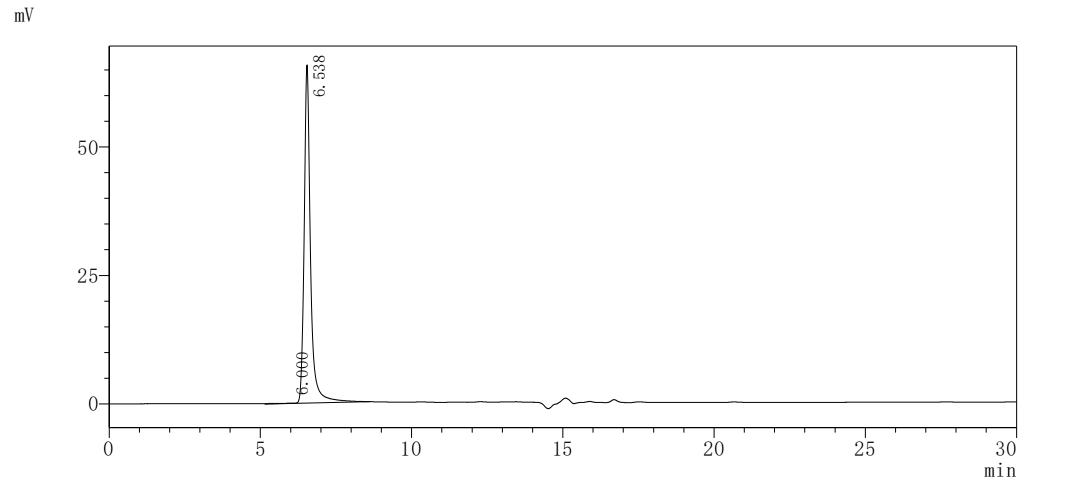Recombinant Human Neuropathy target esterase (PNPLA6), partial
-
中文名称:人PNPLA6重组蛋白
-
货号:CSB-YP809011HU
-
规格:
-
来源:Yeast
-
其他:
-
中文名称:人PNPLA6重组蛋白
-
货号:CSB-EP809011HU
-
规格:
-
来源:E.coli
-
其他:
-
中文名称:人PNPLA6重组蛋白
-
货号:CSB-EP809011HU-B
-
规格:
-
来源:E.coli
-
共轭:Avi-tag Biotinylated
E. coli biotin ligase (BirA) is highly specific in covalently attaching biotin to the 15 amino acid AviTag peptide. This recombinant protein was biotinylated in vivo by AviTag-BirA technology, which method is BriA catalyzes amide linkage between the biotin and the specific lysine of the AviTag.
-
其他:
-
中文名称:人PNPLA6重组蛋白
-
货号:CSB-BP809011HU
-
规格:
-
来源:Baculovirus
-
其他:
-
中文名称:人PNPLA6重组蛋白
-
货号:CSB-MP809011HU
-
规格:
-
来源:Mammalian cell
-
其他:
产品详情
-
纯度:>85% (SDS-PAGE)
-
基因名:PNPLA6
-
Uniprot No.:
-
别名:EC 3.1.1.5; Neuropathy target esterase; NTEMND; Patatin like phospholipase domain containing 6; Patatin like phospholipase domain containing protein 6; Patatin-like phospholipase domain-containing protein 6; PLPL6_HUMAN; Pnpla6; SPG39; sws
-
种属:Homo sapiens (Human)
-
蛋白长度:Partial
-
蛋白标签:Tag type will be determined during the manufacturing process.
The tag type will be determined during production process. If you have specified tag type, please tell us and we will develop the specified tag preferentially. -
产品提供形式:Lyophilized powder
Note: We will preferentially ship the format that we have in stock, however, if you have any special requirement for the format, please remark your requirement when placing the order, we will prepare according to your demand. -
复溶:We recommend that this vial be briefly centrifuged prior to opening to bring the contents to the bottom. Please reconstitute protein in deionized sterile water to a concentration of 0.1-1.0 mg/mL.We recommend to add 5-50% of glycerol (final concentration) and aliquot for long-term storage at -20℃/-80℃. Our default final concentration of glycerol is 50%. Customers could use it as reference.
-
储存条件:Store at -20°C/-80°C upon receipt, aliquoting is necessary for mutiple use. Avoid repeated freeze-thaw cycles.
-
保质期:The shelf life is related to many factors, storage state, buffer ingredients, storage temperature and the stability of the protein itself.
Generally, the shelf life of liquid form is 6 months at -20°C/-80°C. The shelf life of lyophilized form is 12 months at -20°C/-80°C. -
货期:Delivery time may differ from different purchasing way or location, please kindly consult your local distributors for specific delivery time.Note: All of our proteins are default shipped with normal blue ice packs, if you request to ship with dry ice, please communicate with us in advance and extra fees will be charged.
-
注意事项:Repeated freezing and thawing is not recommended. Store working aliquots at 4°C for up to one week.
-
Datasheet :Please contact us to get it.
相关产品
靶点详情
-
功能:Phospholipase B that deacylates intracellular phosphatidylcholine (PtdCho), generating glycerophosphocholine (GroPtdCho). This deacylation occurs at both sn-2 and sn-1 positions of PtdCho. Catalyzes the hydrolysis of several naturally occurring membrane-associated lipids. Hydrolyzes lysophospholipids and monoacylglycerols, preferring the 1-acyl to the 2-acyl isomer. Does not catalyze hydrolysis of di- or triacylglycerols or fatty acid amides.
-
基因功能参考文献:
- This result further confirmed the role of PNPLA6 in BoucherNeuhauser syndrome (BNS) and suggested that whole exome sequencing may be applied for the diagnosis of complex syndromes, including BNS, prior to the observation of obvious symptoms. PMID: 29749493
- Silencing of PNPLA6, the neuropathy target esterase (NTE) codifying gene, alters early neurodevelopment. PMID: 25255935
- These results strongly suggest that PNPLA9, -6 and -4 play a key role in GPL turnover and homeostasis in human cells. A hypothetical model suggesting how these enzymes could recognize the relative concentration of the different GPLs is proposed PMID: 27317427
- The unusual medical history with childhood ataxia and hypogonadotropic hypogonadism lead to further examinations and eventually the diagnosis of BNS. The older sister of the proband also displayed the triad of ataxia, HH and chorioretinal dystrophy accompanied by cerebellar atrophy and in 2014, we found the mutations in PNPLA6. PMID: 27866050
- Data indicate two novel homozygous mutations (one frameshift and one missense mutation) detected in CYP7B1 (SPG5A), while no disease-causing mutation was identified for PNPLA6 (SPG39) and C19orf12 (SPG43). PMID: 26714052
- inducible, neuron-specific expression of full-length human wildtype NTE reduces vacuole formation and substantially rescues mobility. PMID: 26671664
- Eight mutations in six families with Oliver-McFarlane or Laurence-Moon syndrome were identified in the PNPLA6 gene, which encodes neuropathy target esterase. PMID: 25480986
- PNPLA6 has a role in photoreceptor survival; its mutations are linked to photoreceptor degeneration and various forms of childhood blindness PMID: 25574898
- we found a novel compound heterozygous mutation and a novel homozygous one in the PNPLA6 gene in two Japanese patients with BNS. PMID: 25631098
- Data confirm PNPLA6 mutations as the leading cause of Boucher-Neuhauser syndrome and suggest inquiring about a history of hypogonadism or visual changes in patients presenting with late-onset gait ataxia. PMID: 25267340
- These results suggest that hypogonadism-dependent alteration of phospholipid homeostasis in Gordon Holmes syndrome causes both neurodegeneration and impaired LH release from pituitary gonadotropes, leading to the disease. PMID: 25033069
- The activity of NTE was higher in Sick building syndrome patients compared with controls. Population with an AA genotype of a single nucleotide polymorphism, rs480208, in intron 21 of the PNPLA6 gene strongly reduced the activity of NTE. PMID: 23418070
- PNPLA6 influences a manifold of neuronal systems, from the retina to the cerebellum, upper and lower motor neurons and the neuroendocrine system PMID: 24355708
- Neuronal phospholipid deacylation is essential for axonal and synaptic integrity through the action of iPLA2 and NTE. PMID: 22903185
- These results suggested for the first time that NTE is a cell cycle-dependent protein. PMID: 20306302
- Mutations in the neuropathy target esterase (NTE) gene cause autosomal recessive motor neuron disease. The features of affected subjects in the index families are described. PMID: 21171093
- Endogenous NTE activity was increased by cAMP-elevating chemicals, but decreased by the adenyl cyclase inhibitor SQ22536 which can reduce intracellular cAMP levels. PMID: 20380879
- Lack of correlation between reduced fibroblast NTE SA and the occurrence of NTE-MND in NTE insertion mutation heterozygotes indicates that reduction of NTE SA alone is insufficient to cause notor neuron disease. PMID: 20603202
- used the NTE catalytic domain (NEST) to hydrolyze palmitoyl-2-hydroxy-sn-glycero-3-phosphocholine (p-lysoPC) to palmitic acid in bilayer membranes comprising DOPC and NBD-PC PMID: 20346913
- The mutations found in association with NTE-related motor neuron disease have functional correlates in altered enzymological properties of NTE. PMID: 20382209
- catalyzes hydrolysis of membrane lipids PMID: 11927584
- Neuropathy target esterase and its homologues play a central role in membrane lipid homeostasis PMID: 15044461
- All-trans retinoic acid -induced differentiation of the neuroblastoma cells with lowered NTE activity revealed that inhibition of NTE expression does not affect neural differentiation. PMID: 16010971
- Results suggest that reduction of neuropathy target esterase does not affect process outgrowth or differentiation of neuroblastoma cells. PMID: 16122834
- results suggest that the role of NTE over-expression in cell proliferation is associated with different mechanisms in different cells PMID: 16987144
- These findings suggest that stimulation with phorbol 12-myristate 13-acetate reduces the expression of NTE mRNA levels but does not affect the exogenous promoter-driven NTE expression in mammalian cells. PMID: 17385009
- NTE mutations in unrelated motor neuron disease patients indicate NTE's importance in maintaining axonal integrity. PMID: 18313024
- the macroautophagy/lysosome pathway plays a role in controlling NTE quantity, providing a further understanding of the function of NTE. PMID: 19059269
显示更多
收起更多
-
相关疾病:Spastic paraplegia 39, autosomal recessive (SPG39); Boucher-Neuhauser syndrome (BNHS); Laurence-Moon syndrome (LNMS); Oliver-McFarlane syndrome (OMCS)
-
亚细胞定位:Endoplasmic reticulum membrane; Single-pass type III membrane protein.
-
蛋白家族:NTE family
-
组织特异性:Expressed in brain, placenta, kidney, neuron and skeletal muscle. Expressed in the developing eye, pituitary and brain.
-
数据库链接:
Most popular with customers
-
Recombinant Paguma larvata Angiotensin-converting enzyme 2 (ACE2), partial (Active)
Express system: Mammalian cell
Species: Paguma larvata (Masked palm civet)
-
Recombinant Human Tumor necrosis factor ligand superfamily member 8 (TNFSF8), partial (Active)
Express system: Mammalian cell
Species: Homo sapiens (Human)
-
Recombinant Mouse Prolactin receptor (Prlr), partial (Active)
Express system: Mammalian cell
Species: Mus musculus (Mouse)
-
Recombinant Human C5a anaphylatoxin chemotactic receptor 1 (C5AR1)-VLPs (Active)
Express system: Mammalian cell
Species: Homo sapiens (Human)
-
Recombinant Human C-type lectin domain family 4 member C (CLEC4C), partial (Active)
Express system: Mammalian cell
Species: Homo sapiens (Human)
-
Recombinant Human CD70 antigen (CD70), partial (Active)
Express system: Mammalian cell
Species: Homo sapiens (Human)
-
-
Recombinant Human C-C chemokine receptor type 9 (CCR9)-VLPs (Active)
Express system: Mammalian cell
Species: Homo sapiens (Human)


